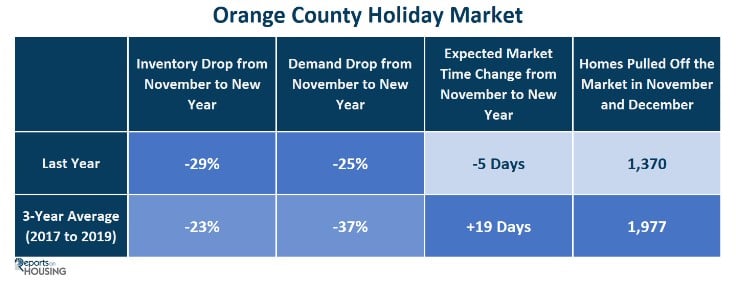A Holiday Plunge
Housing is about to shift to the Holiday Market when both the supply of available homes and purchase demand falls to their lowest levels of the year on New Year’s Day. With all the distractions of the holidays, supply and demand will plunge through the end of the year.
Immediately after all the little ones enjoy going door-to-door trick-or-treating, all the Halloween decorations come down in the snap of a finger. It is the first sign that a holiday downshift is upon us. Daylight savings ends in early November; clocks roll back an hour, and suddenly, it is dark at 5 PM. This is yet another sign. Starbucks cups, holiday romantic movies on Netflix, and neighbors’ early installation of Christmas lights are all further indications that the festivities and distractions of the season are about to hit the housing market.
With Thanksgiving next week, the diversion of family gatherings, holiday parties, plenty of shopping, eggnog, and nonstop festive music has arrived. Orange County transitions to the Holiday Market starting this week in the blink of an eye. The inventory plunges, demand plunges, and the Expected Market Time will not change much this year. This is the season where many sellers and buyers will place their real estate goals and needs on pause to enjoy the merriment.
Last year, the number of available homes grew all year due to surging mortgage rates until it peaked in August at 4,069 homes, reaching levels last seen 22 months earlier in October 2020. After peaking, the inventory dropped to 3,581 to start November, shedding 25%. It was hard to imagine that it could fall further, but during the Holiday Market, November through the New Year, it plunged another 29%, reaching 2,530 during the first week of January. The 3-year average inventory drop before COVID (2017 to 2019) was 23%.
Demand, a snapshot of the number of new pending sales over the prior month, tumbled by 25%, from 1,202 to 900 pending sales during last year’s Holiday Market. The 3-year average dive in demand prior to COVID was 37%. The Expected Market Time, the number of days to sell all Orange County listings at the current buying pace, dropped from 89 to 84 days last year, shedding 5 days. That was far different than the 19-day rise prior to COVID. The difference is because of chronically low inventory levels compared to pre-COVID years.
Contributing to the drop in inventory is the rise in the number of homes pulled off the market in November and December. Last year, 1,370 sellers threw in the proverbial towel, unable to find success and opting to place their desire to sell on hold until a later date. That is more than half the current inventory. The pre-COVID 3-year average was 1,977 when many more homes were available.
The inventory drops during the holidays because fewer homeowners list their homes at the end of the year. The fewest sellers enter the fray in December, 64% less than May, the peak month with the greatest number of new sellers. The second fewest come on in November, 46% less than May’s peak. Fewer FOR-SALE signs combined with sellers throwing in the towel pave the way for the inventory to drop substantially.

Excerpt taken from an article by Steven Thomas.


